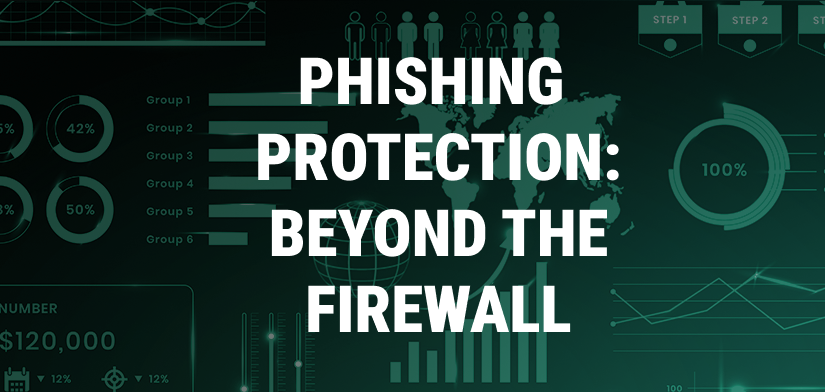Beyond the Firewall: Why Phishing Protection Requires a Brand-First Approach
When most companies think about phishing protection, they focus on internal defenses. Firewalls, email filters, endpoint detection, and employee training are often the go-to strategies. While these are essential, they only address part of the problem.
Today’s phishing attacks are no longer limited to targeting employees through suspicious emails. Many are now aimed directly at your customers and partners by impersonating your brand in the open digital world. This growing trend of external-facing phishing attacks requires a broader approach—one that looks beyond the company firewall and focuses on protecting the brand itself.
The Changing Face of Phishing
Phishing has evolved from simple, mass-sent emails to highly targeted and multi-channel attacks. Threat actors now use fake websites, cloned social media pages, fraudulent ads, and messaging apps to trick users into clicking malicious links, entering sensitive information, or downloading harmful software.
What makes these attacks more dangerous is their focus on brand impersonation. A user who sees a page or message that looks like it came from your company is more likely to trust it. These scams often involve the unauthorized use of your logo, brand colors, product images, and tone of voice. In some cases, the phishing page may appear at the top of a search result or be boosted by paid ads, reaching users before they even find your official site.
This shift in tactics means that phishing is no longer just a cybersecurity concern. It is now a brand protection issue.
Why Internal Defenses Are No Longer Enough
Internal security tools are designed to protect employees and systems within your corporate environment. They can block phishing emails, detect suspicious files, and prevent unauthorized access. However, they cannot monitor what’s happening on social media, in search engine results, or on obscure corners of the internet.
As a result, brands are often unaware that their image is being misused until the damage has already been done. A customer may report a scam after losing money or sharing personal data. By then, the trust in your brand has already been eroded.
This is where a brand-first approach to phishing protection becomes critical. It involves proactively monitoring the broader digital ecosystem to detect and remove threats that target your audience using your brand identity.
What a Brand-First Phishing Protection Strategy Looks Like
A comprehensive phishing protection plan should include both internal and external safeguards. While your IT team continues to secure the internal network, your marketing, legal, and brand protection teams should work together to defend your digital presence across the public web.
Here’s what a brand-first strategy involves:
1. Proactive Monitoring Across Digital Channels
Rather than waiting for customer complaints or security incidents, your team should continuously scan the internet for phishing activity. This includes unofficial websites, social media platforms, mobile apps, and even advertising networks. By monitoring for suspicious use of your brand name, logos, and domains, you can catch impersonation early and act quickly.
2. AI-Powered Threat Detection
With phishing tactics becoming more complex, automation is essential. BrandShield, for example, uses AI-driven detection tools to identify patterns of fraudulent activity and surface the most critical threats. This allows brands to focus their response efforts where it matters most.
3. Expert Enforcement and Fast Takedowns
Once a phishing site or fake profile is discovered, speed is key. A fast takedown can minimize exposure and limit the number of victims. BrandShield combines automated enforcement workflows with an experienced legal team that understands how to navigate different platform policies and regional regulations to remove malicious content efficiently.
4. Cluster Detection and Risk Mapping
Phishing threats often do not appear in isolation. Scammers may operate in coordinated clusters across multiple platforms and regions. A brand-first phishing protection system should include tools that map and connect related threats to uncover larger fraud networks. This helps prevent future attacks and gives your team a strategic view of the threat landscape.
5. Transparent Reporting and Performance Metrics
A successful phishing protection program should be measurable. Regular reports showing takedown rates, threat volumes, and time-to-removal help track effectiveness and support internal alignment with leadership and stakeholders.
The Business Impact of Brand-Focused Phishing
Beyond the obvious cybersecurity risks, phishing attacks that impersonate your brand have serious business consequences. They lead to lost revenue when customers buy from fraudulent sellers. They result in support costs when your team has to manage angry or confused users. And they damage trust, which can take years to rebuild.
In regulated industries such as finance, healthcare, or pharmaceuticals, there can also be legal liabilities. Failing to take reasonable steps to prevent consumer-facing scams may expose the company to compliance risks or reputational fallout.
Protecting your brand is no longer a marketing issue—it is a business-critical function that touches cybersecurity, legal, customer experience, and revenue protection.
Final Thoughts
Phishing threats are evolving, and so should your strategy. While firewalls and endpoint protection remain vital, they cannot defend your brand in the vast, unregulated corners of the internet. A brand-first phishing protection approach fills that gap by actively identifying and eliminating threats wherever they appear.
By expanding your view beyond internal networks and putting brand protection at the core of your phishing defense, you not only safeguard your customers and partners, you strengthen the foundation of trust that your business depends on.
